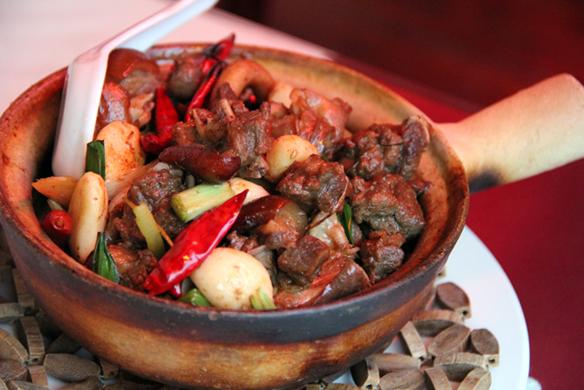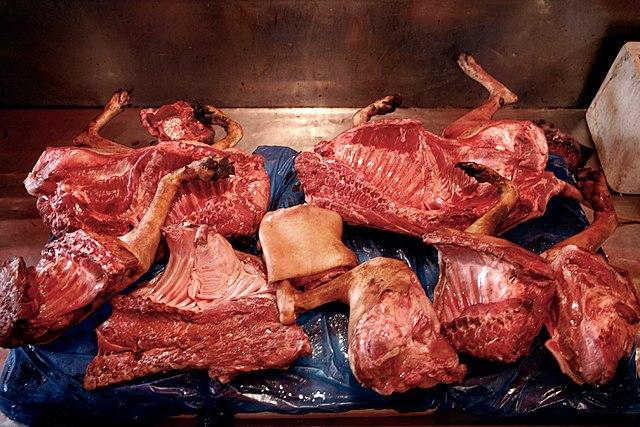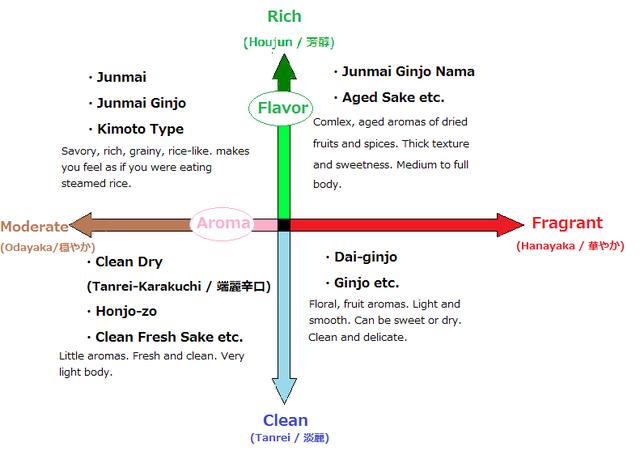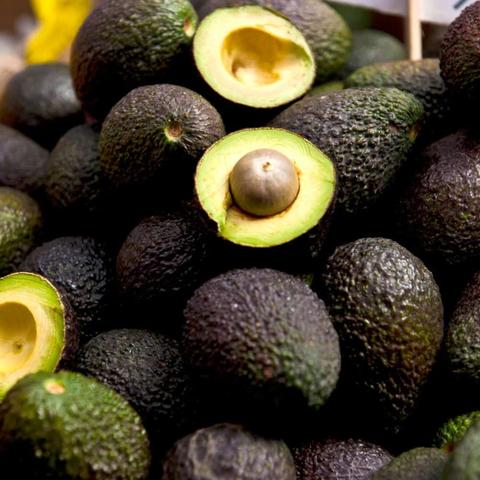
Curious about the taste of dogs? Unlocking the mystery, we delve into the intriguing question: What does dog taste like? Discover fascinating insights and explore cultural perspectives surrounding this controversial topic. Join us on a thought-provoking journey to satisfy your curiosity and expand your culinary knowledge.
1. Exploring the Taste of Dog Meat: What Does It Really Taste Like?
Taste and Texture:
Dog meat is described as hard and tough, making it difficult to chew and loosen the meat fiber between the teeth. Some people compare its texture to beef but note that it is much tougher. The taste of dog meat alone is often reported as not having a recognizable flavor.

Preparation and Cooking:
The taste of dog meat can vary depending on how it is prepared and cooked. In some instances, common spices are sprinkled and basted on the meat before cooking. It may be wrapped in banana leaves and placed in a pit with large smooth stones over burning charcoals for several hours. The addition of spices, such as vinegar mixed with salt, pepper, shredded onions, and garlic, can give dog meat a distinct taste.
Comparison to Other Meats:
Some individuals who have tried dog meat compare its taste to lamb or mutton. However, due to the fading memory of the specific experience, it is difficult to make an accurate comparison.
Overall, the taste of dog meat can vary depending on factors such as preparation methods and personal preferences. It is important to consider cultural differences and individual opinions when discussing this topic.
2. Curiosity Satisfied: My Experience Eating Dog Meat and Its Taste
Paragraph 1:
When I first encountered chunks of dog meat, I mistook it for beef due to its appearance. However, I quickly realized that dog meat is hard and tough, making it difficult to chew and loosen the meat fiber between my teeth. Even when I managed to rip off some fiber, it took a long time to digest. Surprisingly, the meat alone didn’t have a recognizable taste. It all seemed to depend on how the dog meat was prepared and cooked.
Paragraph 2:
The dog meat I tried was sprinkled and basted with some common spices before being wrapped in banana leaves. It was then placed in a pit with large smooth stones over burning charcoals for several hours. The cooking process involved covering the meat with more banana leaves. To enhance the taste, I dipped the cooked dog meat in vinegar mixed with salt, pepper, shredded onions, and garlic. It was this vinegar spice mixture that gave the dog meat its flavor. However, even with the added spices, the dog meat itself didn’t have a sharp or strong taste.
Paragraph 3:
Honestly, I didn’t enjoy the experience of eating dog meat as it made me feel uncomfortable and hot in the ears. This happened during my visit to Vietnam where I stayed in a rural village for a month. While dining at a gathering with friends and colleagues of my father who worked there, I unknowingly consumed dog meat thinking it was lamb due to its taste similarity. When my mother noticed my reaction, she informed me about what I had just eaten. Although I had previously tried other unusual foods like snails and frogs during this trip, discovering that I had eaten dog made me hesitant to consume more of it.
Note: The content provided is a summary based on the given information.
3. The Surprising Flavor of Dog Meat: A Closer Look at its Taste

A Difficult Texture and Lack of Recognizable Taste
The author describes their experience of eating dog meat as hard and tough, making it difficult to chew and loosen the meat fiber between the teeth. They also mention that even if they were able to rip off some fiber, it would still take a long time to digest. Furthermore, the meat alone didn’t have a recognizable taste at all. It is suggested that the taste of dog meat may depend on how it is prepared and cooked, as in the author’s case, where the dog meat was sprinkled and basted with common spices before being wrapped in banana leaves and cooked for hours.
The Influence of Spices and Preparation Methods
The author explains that the dog meat they tried had a taste primarily influenced by the vinegar mixed with salt, pepper, shredded onions, and garlic that they used as a dipping sauce. They note that without these spices, the dog meat itself didn’t have a sharp or strong taste. This suggests that the flavor of dog meat can be enhanced or altered through various cooking techniques and seasoning choices.
Personal Experiences Eating Dog Meat in Different Cultures
The content also includes personal anecdotes from individuals who have eaten dog meat in different cultural contexts. One person shares their experience of accidentally eating dog meat during a dinner gathering in Vietnam. They initially mistook it for lamb but soon realized what they had consumed. Despite not being upset about eating dog meat due to previous experiences eating unconventional foods, they highlight their disapproval of how dogs are treated before being killed for consumption.
Another individual mentions Native Americans who historically ate dog meat, describing it as tasting like pork. They also mention a documentary about individuals during the siege of Stalingrad resorting to eating cats due to extreme hunger. While acknowledging that sentiment plays a role in not eating companion animals, they suggest that from a purely meat perspective, such animals would be considered wholesome if healthy.
Overall, these accounts shed light on the texture and taste of dog meat, as well as cultural perspectives and personal opinions surrounding its consumption.
4. From Beef to Lamb: Unveiling the True Taste of Dog Meat

The Initial Misconception
When I first encountered chunks of dog meat, I mistook them for beef due to their appearance. However, upon tasting it, I quickly realized that dog meat has a distinct texture and toughness that sets it apart. It is difficult to chew and loosen the meat fiber between the teeth, making it a challenging eating experience. Even if some fibers can be ripped off, digestion can still take a considerable amount of time. Surprisingly, the meat itself doesn’t have a recognizable taste at all. The flavor heavily depends on how the dog meat is prepared and cooked.
The Preparation Process
The dog meat I tried was sprinkled and basted with common spices before being wrapped in banana leaves. It was then placed in a pit with large smooth stones over burning charcoals. The entire setup was covered with more banana leaves and allowed to cook for hours. The final result was a well-seasoned piece of meat with an intriguing taste.
The Unique Flavor Profile
To enhance the taste of the dog meat, I dipped it in vinegar mixed with salt, pepper, shredded onions, and garlic. This combination of spices gave the meat its distinctive flavor. However, even with these added flavors, the dog meat alone didn’t have a sharp or strong taste. Instead, it resembled lamb or mutton in terms of flavor profile.
In conclusion, my personal experience with consuming dog meat revealed that it can resemble lamb or mutton in taste when properly prepared and cooked. However, it is important to consider ethical concerns surrounding the consumption of dogs as they are often stolen pets or mistreated animals. While there may be cultural differences in food choices and preferences, it is essential to approach such topics with sensitivity and respect for different perspectives.
5. The Intriguing Culinary Adventure: Discovering the Flavor of Dog Meat
Paragraph 1:
The author recounts their experience of eating dog meat in a U.S. territory in the Pacific out of curiosity. Initially mistaking it for beef, they found dog meat to be hard and tough, making it difficult to chew and loosen the meat fiber between their teeth. The taste of the meat alone was not recognizable, but they speculate that it depends on how the dog meat is prepared and cooked.
Paragraph 2:
The author describes how the dog meat they tried was prepared – sprinkled and basted with common spices, wrapped in banana leaves, placed in a pit with large smooth stones over burning charcoals, covered with more banana leaves, and allowed to cook for hours. They ate the meat by dipping it in vinegar mixed with salt, pepper, shredded onions, and garlic. It was this vinegar with spices that gave the dog meat its taste. However, despite these preparations, the author did not enjoy the experience.
Paragraph 3:
Another individual shares their experience of accidentally eating dog meat while visiting Vietnam. They were at a gathering where lots of people were sitting around a pile of food. Thinking it was lamb, they put a piece of meat in their mouth but soon realized it was dog meat. While they weren’t upset about eating it due to their previous adventurous eating experiences, they were bothered by people trying to pass off the dog meat as pork.
Paragraph 4:
A Vietnamese individual from Hanoi expresses their opinion on eating dog meat. They acknowledge that although dog meat is considered good quality protein and has a desirable texture when cooked properly, they are against consuming it for several reasons. These include personal love for dogs and owning one themselves, concerns about stolen dogs being eaten, and witnessing the inhumane treatment of dogs during transportation.
Paragraph 5:
The author briefly mentions historical instances of people eating dog meat, such as Native Americans and residents of Stalingrad during the siege. They highlight that sentiment is what keeps us from eating companion animals, and it seems outrageous to treat our faithful friends in such a way. However, they acknowledge that solely considering them as meat, if healthy, there would be no reason why these animals couldn’t be consumed.
6. Dog Meat’s Unique Taste Profile: A Comparison to Other Meats

Moral Issues Surrounding Dog Meat Consumption
While some individuals appreciate the nutritional value of dog meat due to its protein content and lean texture, there are moral concerns associated with consuming this type of meat. Many people love dogs as pets and consider them part of their families. The fact that most dogs used for consumption are stolen from owners adds an ethical dimension to the practice. Additionally, instances of dog thieves being beaten to death by enraged villagers highlight the strong emotions tied to this issue. Furthermore, the inhumane conditions in which dogs are transported and the suffering they endure during smuggling raise further objections to eating dog meat.
Comparisons with Other Animals
There have been historical instances of certain cultures consuming animals that are typically considered pets or companions. Native Americans, for example, have been known to eat dog meat, which is said to taste similar to pork. In a documentary about the siege of Stalingrad, museum staff members resorted to eating cats due to extreme hunger, with one woman even remarking that cats were delicious. These examples illustrate that sentiment and cultural norms play a significant role in determining which animals are considered acceptable for consumption.
In conclusion, the taste of dog meat can vary depending on preparation and cooking methods. While some describe it as similar to lamb or mutton, others find it difficult to pinpoint a distinct flavor. However, ethical concerns surrounding the sourcing and treatment of dogs used for consumption contribute to objections against eating dog meat. Cultural attitudes and personal experiences also shape perceptions of what animals are deemed suitable for consumption. Ultimately, individual opinions on this matter may differ based on personal beliefs and values.
8. The Controversial Delicacy: Understanding the Flavors of Dog Meat
The Texture and Taste of Dog Meat
Dog meat is known for its hard and tough texture, making it difficult to chew and loosen the meat fiber between the teeth. It can take a long time to digest due to its toughness. The meat alone doesn’t have a recognizable taste, but it heavily depends on how it is prepared and cooked. In some cases, dog meat may be sprinkled and basted with common spices, wrapped in banana leaves, and cooked for hours over burning charcoals. The addition of vinegar mixed with salt, pepper, onions, and garlic can give the dog meat a distinct taste.
Cultural Experiences with Dog Meat
In certain cultures like Vietnam or some Native American tribes, dog meat is consumed as a delicacy. While some people enjoy the taste of dog meat and compare it to lamb or mutton, others find it unsettling due to personal preferences or their love for dogs as pets. There are also moral concerns surrounding the consumption of dog meat, especially when dogs are stolen or mistreated before being slaughtered.
The Controversy Surrounding Dog Meat Consumption
Eating dog meat can be a controversial topic due to various reasons. Many individuals who love dogs or own them themselves are against consuming dog meat out of compassion for these animals. Additionally, there have been cases where dogs are stolen from families, leading to outrage from communities who take matters into their own hands by violently confronting dog thieves.
Furthermore, there are reports of dogs being smuggled in cruel conditions from neighboring countries like Laos into Vietnam. These dogs are often transported in cramped cages and subjected to injuries during transportation. Despite these controversies and moral concerns, some argue that if considered solely as meat, healthy animals like dogs could be consumed without any issues.
It is important to note that the consumption of dog meat varies greatly across different cultures and personal beliefs. The controversy surrounding this delicacy highlights the complex relationship between food, culture, ethics, and personal preferences.
9. A Memorable Encounter: Reflecting on the Taste of Dog Meat

A Surprising Discovery
During a visit to a U.S. territory in the Pacific, I had a memorable encounter with dog meat. At first glance, the chunks of meat resembled beef, leading me to believe that was what I was about to consume. However, upon tasting it, I realized that dog meat has a distinct texture and taste. It is hard and tough, making it difficult to chew and loosen the meat fiber between the teeth. Despite its challenging texture, the taste of dog meat alone was not recognizable or distinctive. It became evident that the flavor heavily relied on how it was prepared and cooked.
The Preparation Process
The dog meat I tried was seasoned with common spices and basted before being wrapped in banana leaves. It was then placed in a pit with large smooth stones over burning charcoals for several hours to cook slowly. The cooking process allowed the flavors to develop and infuse into the meat. When it came time to eat, I dipped the cooked dog meat in vinegar mixed with salt, pepper, shredded onions, and garlic. This combination of spices gave the dog meat its taste.
A Personal Reflection
Personally, I did not enjoy the experience of eating dog meat as it left me feeling uncomfortable and red-hot in my ears. The taste reminded me somewhat of lamb or mutton but lacked a strong or sharp flavor profile. While some may find pleasure in consuming dog meat, my personal preference leans towards other types of protein sources.
In conclusion, my encounter with dog meat provided an opportunity for reflection on different cultural practices surrounding food consumption. While some regions consider dog meat a delicacy or partake in its consumption due to cultural beliefs or availability of resources, others may have ethical concerns regarding animal welfare or personal attachments to dogs as companion animals. Ultimately, taste preferences and cultural perspectives play a significant role in shaping our views on consuming dog meat.
10. Breaking Taboos: Exploring the Palate-Pleasing Aspects of Dog Meat
Paragraph 1:
In this article, the author recounts their personal experience of eating dog meat in a U.S. territory in the Pacific. They describe the texture and taste of the meat, noting that it was hard and tough to chew and lacked a recognizable taste on its own. The author suggests that the preparation and cooking methods may greatly influence the flavor of dog meat.
Paragraph 2:
The author further elaborates on their experience with dog meat during a trip to Vietnam. They explain how they unknowingly consumed dog meat at a dinner party and initially mistook it for lamb. However, upon realizing it was dog meat, they were taken aback but not overly upset due to their previous adventurous food experiences. The author also mentions that some people at the gathering tried to pass off the dog meat as pork.
Paragraph 3:
Another contributor to this discussion shares their perspective as someone born and raised in Hanoi, Vietnam. They express their personal aversion to eating dog meat, citing reasons such as their love for dogs and witnessing cases of stolen dogs being consumed. The contributor also highlights the inhumane treatment of dogs during transportation, mentioning instances of smuggled dogs being trapped in small cages and suffering injuries.
Paragraph 4:
The topic takes a broader view as another individual brings up historical examples of cultures consuming animals typically considered companions or pets. They mention Native Americans who ate dog meat and suggest that it tastes similar to pork. Additionally, they recount a documentary about individuals during the siege of Stalingrad resorting to eating cats out of desperation.
Overall, these perspectives provide different insights into the consumption of dog meat, including personal experiences, cultural beliefs, ethical concerns, and historical references. It is important to note that opinions on this topic vary greatly, and cultural norms, personal beliefs, and ethical considerations play a significant role in shaping individual perspectives on consuming dog meat.
In conclusion, while dog meat consumption is a cultural practice in some regions, it remains highly controversial due to ethical concerns and potential health risks. The taste of dog meat has been described as gamey and similar to other meats, but the decision to consume it should be weighed against individual values and societal norms. Ultimately, promoting compassion and responsible food choices should be prioritized for the well-being of both animals and humans.
Learn More About Grilling
If you want to learn more about grilling, check out these other helpful resources!






